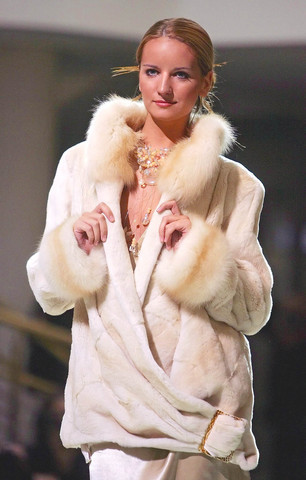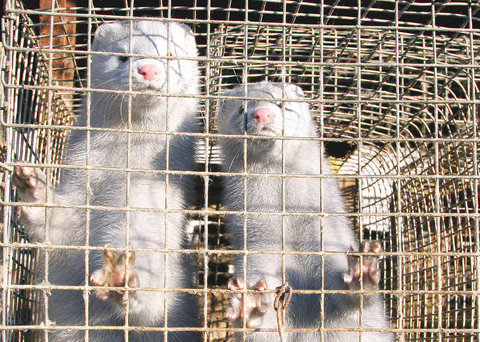From Soviet leaders to high society icons, a Russian fur coat was once seen as a desirable status symbol. But as Russians increasingly favor foreign imports, the Pushkino fur farm near Moscow is barely surviving.
The problems of Russia's fur industry are unrelated to ethical scruples of the kind that have put the industry under pressure in the West. It is the sector's inability to keep up with Western brands since the collapse of communism that is the real problem, observers say.
The farm at Pushkino was once the most celebrated in the Soviet Union. But a glance at its run-down buildings shows how far things have slipped.

PHOTO: EPA
"When I came here a year-and-a-half ago I was shocked," said Nikolai Yumanshev, a former space industry official recently installed as chief executive.
Yumanshev was brought in when the farm was bought by an energetic young millionaire, Denis Lavrov. It had already declared bankruptcy.
Even now, dealing with a legacy of neglect left by the previous state, management is proving an uphill task.

PHOTO: AFP
The animals at the farm were underfed, the mothers were giving birth to fewer and fewer offspring and the quality of the pelts had suffered.
"The water supply system, the electricity, the buildings, the heating system were all rotten," he said.
The picture is similar or worse throughout what remains of Russia's fur industry.
Of the 300 Russian fur farms that once provided 30 percent of world output, around 20 remain. Pushkino is one of just four left in the Moscow region.
"All the fur farms are closing, one after the other. We can't compete with China and Denmark," Pushkino's technical director, Vladimir Kudryavtsev, complained.
"China has taken over the fur market as far west as the Urals and Greek producers sell us poor quality items made from pelts that they buy here," the head of Pushkino's sewing workshop, Alexander Isayev, said.
Officials at Pushkino say they are gradually getting their farm back on track.
It now produces 100,000 pelts per year, including blue and silver fox, mink and sable -- the latter a Russian speciality. Pushkino claims to produce half of all sable -- sable coats fetching as much as US$150,000.
Nonetheless, the buildings remain in disarray and the company appears reluctant to copy Western fashion techniques, such as stret-ching pelts by machine to create a lighter fabric.
Yumanshev says there is still a market for more traditional heavier coats in a harsh climate like Russia's.
"In Europe, women wear furs like jewellery. They are beautiful of course, but in Russia the fur has to be thick and warm -- it's essential," he said. "We work by traditional methods here."
The problems of the company have more to do with the specifics of the Russian business environment, he insists.
These include the enormous size of the country it sells its products in and the farm's distance from the sea. The latter raises the cost of bringing in fish -- an important part of the animals' diet.
There are also difficulties intrinsic to the business, such as the fact that vixen are fertile for just three days per year.
But the biggest problem is the inefficient state bureaucracy.
Yumanshev says he spends much of his time battling local officials in order to obtain licenses and avoid fines for imaginary offenses.
"We get the impression the state is trying to destroy this profession," Kudryavtsev said.

April 14 to April 20 In March 1947, Sising Katadrepan urged the government to drop the “high mountain people” (高山族) designation for Indigenous Taiwanese and refer to them as “Taiwan people” (台灣族). He considered the term derogatory, arguing that it made them sound like animals. The Taiwan Provincial Government agreed to stop using the term, stating that Indigenous Taiwanese suffered all sorts of discrimination and oppression under the Japanese and were forced to live in the mountains as outsiders to society. Now, under the new regime, they would be seen as equals, thus they should be henceforth

Last week, the the National Immigration Agency (NIA) told the legislature that more than 10,000 naturalized Taiwanese citizens from the People’s Republic of China (PRC) risked having their citizenship revoked if they failed to provide proof that they had renounced their Chinese household registration within the next three months. Renunciation is required under the Act Governing Relations Between the People of the Taiwan Area and the Mainland Area (臺灣地區與大陸地區人民關係條例), as amended in 2004, though it was only a legal requirement after 2000. Prior to that, it had been only an administrative requirement since the Nationality Act (國籍法) was established in

Three big changes have transformed the landscape of Taiwan’s local patronage factions: Increasing Democratic Progressive Party (DPP) involvement, rising new factions and the Chinese Nationalist Party’s (KMT) significantly weakened control. GREEN FACTIONS It is said that “south of the Zhuoshui River (濁水溪), there is no blue-green divide,” meaning that from Yunlin County south there is no difference between KMT and DPP politicians. This is not always true, but there is more than a grain of truth to it. Traditionally, DPP factions are viewed as national entities, with their primary function to secure plum positions in the party and government. This is not unusual

US President Donald Trump’s bid to take back control of the Panama Canal has put his counterpart Jose Raul Mulino in a difficult position and revived fears in the Central American country that US military bases will return. After Trump vowed to reclaim the interoceanic waterway from Chinese influence, US Defense Secretary Pete Hegseth signed an agreement with the Mulino administration last week for the US to deploy troops in areas adjacent to the canal. For more than two decades, after handing over control of the strategically vital waterway to Panama in 1999 and dismantling the bases that protected it, Washington has